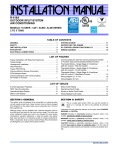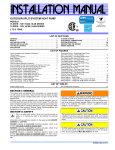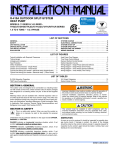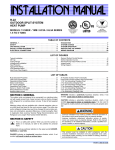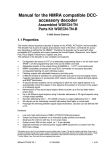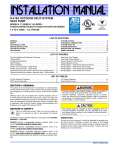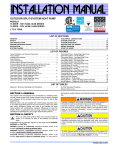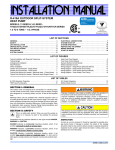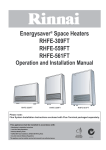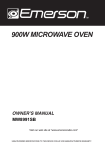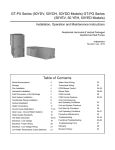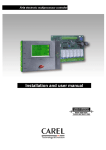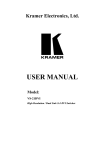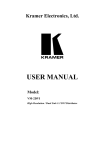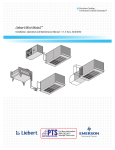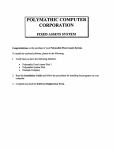Download York HL6B Installation manual
Transcript
INSTALLATION MANUAL
OUTDOOR SPLIT-SYSTEM HEAT PUMP
MODELS:
13 SEER - YZB SERIES
15 SEER - YZE, HC5B, HL5B SERIES
16 SEER - YZF, HC6B, HL6B SERIES
18 SEER - YZH, HC8B, HL8B SERIES
2 TO 5 TONS
LISTED
ISO 9001
Certified Quality
Management System
TABLE OF CONTENTS
GENERAL . . . . . . . . . . . . . . . . . . . . . . . . . . . . . . . . . . . . . . . . . . . . . .1
SAFETY . . . . . . . . . . . . . . . . . . . . . . . . . . . . . . . . . . . . . . . . . . . . . . . .1
UNIT INSTALLATION . . . . . . . . . . . . . . . . . . . . . . . . . . . . . . . . . . . . .2
ORIFICE INSTALLATION . . . . . . . . . . . . . . . . . . . . . . . . . . . . . . . . . .5
TXV INSTALLATIONS . . . . . . . . . . . . . . . . . . . . . . . . . . . . . . . . . . . .5
EVACUATION . . . . . . . . . . . . . . . . . . . . . . . . . . . . . . . . . . . . . . . . . . .6
SYSTEM CHARGE . . . . . . . . . . . . . . . . . . . . . . . . . . . . . . . . . . . . . . 6
ELECTRICAL CONNECTIONS . . . . . . . . . . . . . . . . . . . . . . . . . . . . . 7
SYSTEM OPERATION . . . . . . . . . . . . . . . . . . . . . . . . . . . . . . . . . . . 14
INSTRUCTING THE OWNER . . . . . . . . . . . . . . . . . . . . . . . . . . . . . 15
WIRING DIAGRAM . . . . . . . . . . . . . . . . . . . . . . . . . . . . . . . . . . . . . 16
LIST OF FIGURES
Typical Installation with Required Clearances . . . . . . . . . . . . . . . . . . .2
Tubing Hanger . . . . . . . . . . . . . . . . . . . . . . . . . . . . . . . . . . . . . . . . . . .3
Underground Installation . . . . . . . . . . . . . . . . . . . . . . . . . . . . . . . . . . .4
Heat Protection . . . . . . . . . . . . . . . . . . . . . . . . . . . . . . . . . . . . . . . . . .4
Orifice Installation . . . . . . . . . . . . . . . . . . . . . . . . . . . . . . . . . . . . . . . . .5
Typical Field Wiring . . . . . . . . . . . . . . . . . . . . . . . . . . . . . . . . . . . . . . .7
Communications Harness Connection . . . . . . . . . . . . . . . . . . . . . . . . .7
CFM Selection Board . . . . . . . . . . . . . . . . . . . . . . . . . . . . . . . . . . . . . .8
Communicating HP with Communicating Air Handler or Furnace . . . .8
Communicating HP with Non-Communicating Air Handler
or Furnace using Communicating Interface Control . . . . . . . . . . . . . . .8
Thermostat Wiring – Single Stage Air Conditioner
(with AC control) – PSC Air Handler . . . . . . . . . . . . . . . . . . . . . . . . . .9
Thermostat Wiring – Single Stage Air Conditioner
(with AC control) – VS Air Handler . . . . . . . . . . . . . . . . . . . . . . . . . .
Thermostat Wiring – Single Stage Air Conditioner
(with AC control) – Modulating Furnace . . . . . . . . . . . . . . . . . . . . . .
Thermostat Wiring – Single Stage Air Conditioner
(with AC control) – Modulating Furnace . . . . . . . . . . . . . . . . . . . . . .
Thermostat Wiring – Single Stage Air Conditioner
(with AC control) – Modulating Furnace . . . . . . . . . . . . . . . . . . . . . .
Heat Pump Flow Diagram . . . . . . . . . . . . . . . . . . . . . . . . . . . . . . . . .
Wiring Diagram - Single Stage . . . . . . . . . . . . . . . . . . . . . . . . . . . . .
Wiring Diagram - 2 Stage with PSC Outdoor Fan Motor . . . . . . . . .
Wiring Diagram - 2 Stage with ECM Outdoor Fan Motor . . . . . . . . .
10
11
12
13
14
16
17
18
LIST OF TABLES
Defrost Initiate Curves . . . . . . . . . . . . . . . . . . . . . . . . . . . . . . . . . . . .14
R-410A Saturation Properties . . . . . . . . . . . . . . . . . . . . . . . . . . . . . . 15
SECTION I: GENERAL
The outdoor units are designed to be connected to a matching indoor
coil with sweat connect lines. Sweat connect units are factory charged
with refrigerant for the smallest rated indoor coil plus 15 feet of field
supplied lines.
Matching indoor coils are available with a thermal expansion valve or
an orifice liquid feed sized for the most common usage. The orifice size
and/or refrigerant charge may need to be changed for some indoor-outdoor unit combinations, elevation differences or total line lengths. Refer
to Application Data covering “General Piping Recommendations and
Refrigerant Line Length” (Part Number 247077).
SECTION II: SAFETY
This is a safety alert symbol. When you see this symbol on
labels or in manuals, be alert to the potential for personal
injury.
Understand and pay particular attention to the signal words DANGER,
WARNING, or CAUTION.
DANGER indicates an imminently hazardous situation, which, if not
avoided, will result in death or serious injury.
WARNING indicates a potentially hazardous situation, which, if not
avoided, could result in death or serious injury.
CAUTION indicates a potentially hazardous situation, which, if not
avoided may result in minor or moderate injury. It is also used to
alert against unsafe practices and hazards involving only property damage.
Improper installation may create a condition where the operation of
the product could cause personal injury or property damage.
Improper installation, adjustment, alteration, service or maintenance
can cause injury or property damage. Refer to this manual for assistance or for additional information, consult a qualified contractor,
installer or service agency.
This product must be installed in strict compliance with the enclosed
installation instructions and any applicable local, state, and national
codes including, but not limited to building, electrical, and mechanical
codes.
R-410A systems operate at higher pressures than R-22 systems. Do
not use R-22 service equipment or components on R-410A equipment. Service equipment Must Be Rated for R-410A.
573328-UIM-A-1010
573328-UIM-A-1010
INSPECTION
SECTION III: UNIT INSTALLATION
As soon as a unit is received, it should be inspected for possible damage during transit. If damage is evident, the extent of the damage
should be noted on the carrier’s delivery receipt. A separate request for
inspection by the carrier’s agent should be made in writing. See Local
Distributor for more information.
LOCATION
Requirements For Installing/Servicing R-410A Equipment
•
•
•
•
•
•
•
Gauge sets, hoses, refrigerant containers, and recovery system
must be designed to handle POE oils, and the higher pressures
of R-410A.
Manifold sets should be 800 PSIG high side and 250 PSIG low
side with 550 PSIG low side restart.
All hoses must have a 700 PSIG service pressure rating.
Leak detectors should be designed to detect HFC refrigerant.
Recovery equipment (including refrigerant recovery containers)
must be specifically designed to handle R-410A.
Do not use an R-22 TXV.
A liquid-line filter drier is required on every unit.
LIMITATIONS
The unit should be installed in accordance with all National, State and
Local Safety Codes and the limitations listed below:
1. Limitations for the indoor unit, coil and appropriate accessories must
also be observed.
2. The outdoor unit must not be installed with any duct work in the air
stream. The outdoor fan is the propeller type and is not designed to
operate against any additional external static pressure.
3. The maximum and minimum conditions for operation must be
observed to assure a system that will give maximum performance
with minimum service.
Air Temperature DB
at Outdoor Coil, °F
Min.
Max.
Cool
Heat
Cool
Heat
50
-10
115
75
Air Temperature DB
at Indoor Coil, °F
Min.
Max.
WB
DB
WB
DB
Cool
Heat
Cool
Heat
57
501
72
80
1. Operation below this temperature is permissible for a short period of
time, during morning warm-up.
4. This unit is not designed to operate with a low ambient kit. Do not
modify the control system to operate with any kind of low ambient
kit.
5. The maximum allowable line length for this product is 75 feet.
Before starting the installation, select and check the suitability of the
location for both the indoor and outdoor unit. Observe all limitations and
clearance requirements.
The outdoor unit must have sufficient clearance for air entrance to the
condenser coil, for air discharge and for service access. See Figure 1.
NOTICE
For multiple unit installations, units must be spaced a minimum of 18
inches apart. (Coil face to coil face.)
If the unit is to be installed on a hot sun exposed roof or a black-topped
ground area, the unit should be raised sufficiently above the roof or
ground to avoid taking the accumulated layer of hot air into the outdoor
unit.
Provide an adequate structural support.
ADD-ON REPLACEMENT/RETROFIT
When this unit is being used as a replacement for an R-22 unit, it is
required that the outdoor unit, indoor coil, and metering device all be
replaced. The following steps should be performed in order to insure
proper system operation and performance. Line-set change out is also
recommended.
1. Change-out of the indoor coil to an approved R-410A coil/ condensing unit combination with the appropriate metering device.
2. Change-out of the line-set when replacing an R-22 unit with an
R410-A unit is highly recommended to reduce cross-contamination
of oils and refrigerants.
3. If change-out of the line set is not practical, then the following precautions should be taken.
• Inspect the line set for kinks, sharp bends, or other restrictions,
and for corrosion.
• Determine if there are any low spots which might be serving as
oil traps.
• Flush the line set with a commercially available flush kit to
remove as much of the existing oil and contaminants as possible.
• Install a suction line filter-drier to trap any remaining contaminants, and remove after 50 hours of operation.
4. If the outdoor unit is being replaced due to a compressor burnout,
then installation of a 100% activated alumina suction-line filter drier
in the suction-line is required, in addition to the factory installed liquid-line drier. Operate the system for 10 hours. Monitor the suction
drier pressure drop. If the pressure drop exceeds 3 psig, replace
both the suction-line and liquid-line driers. After a total of 10 hours
run time where the suction-line pressure drop has not exceeded 3
psig, replace the liquid line drier, and remove the suction-line drier.
Never leave a suction-line drier in the system longer than 50 hours
of run time.
THERMOSTAT
NEC CLASS 1
WIRING
TO INDOOR
BLOWER
NEC CLASS 2
WIRING
WEATHERPROOF
DISCONNECT SWITCH
48” OVERHEAD
CLEARANCE
TO COIL
24” SERVICE
ACCESS
CLEARANCE
SEAL OPENINGS WITH
PERMAGUM OR EQUIVALENT
NOTE:
ALL OUTDOOR WIRING
MUST BE WEATHERPROOF
18” FRONT
& SIDES
FIGURE 1: Typical Installation with Required Clearances
2
Johnson Controls Unitary Products
573328-UIM-A-1010
GROUND INSTALLATION
PIPING CONNECTIONS
The unit may be installed at ground level on a solid base that will not
shift or settle, causing strain on the refrigerant lines and possible leaks.
Maintain the clearances shown in Figure 1 and install the unit in a level
position.
Normal operating sound levels may be objectionable if the unit is placed
directly under windows of certain rooms (bedrooms, study, etc.).
Condensate will drain from beneath the coil of the outdoor unit during
the defrost cycle. Normally this condensate may be allowed to drain
directly on the ground.
The outdoor unit should not be installed in an area where mud or ice
could cause personal injury. Remember that condensate will drip from
the unit coil during heat and defrost cycles and that this condensate
will freeze when the temperature of the outdoor air is below 32°F.
Elevate the unit sufficiently to prevent any blockage of the air entrances
by snow in areas where there will be snow accumulation. Check the
local weather bureau for the expected snow accumulation in your area.
Isolate the unit from rain gutters to avoid any possible wash out of the
foundation.
This system uses R-410A refrigerant which operates at higher pressures than R-22. No other refrigerant may be used in this system.
Gauge sets, hoses, refrigerant containers, and recovery system must
be designed to handle R-410A. If you are unsure, consult the equipment manufacturer.
Never install a suction-line filter drier in the liquid line of an R-410A
system. Failure to follow this warning can cause a fire, injury or death.
The outdoor unit must be connected to the indoor coil using field supplied refrigerant grade copper tubing that is internally clean and dry.
Units should be installed only with the tubing sizes for approved system
combinations as specified in Tabular Data Sheet. The charge given is
applicable for total tubing lengths up to 15 feet. See Application Data
Part Number 247077 for installing tubing of longer lengths and elevation
differences.
NOTICE
ROOF INSTALLATION
When installing units on a roof, the structure must be capable of supporting the total weight of the unit, including a pad, lintels, rails, etc.,
which should be used to minimize the transmission of sound or vibration into the conditioned space.
UNIT PLACEMENT
1.
2.
3.
4.
Provide a base in the pre-determined location.
Remove the shipping carton and inspect for possible damage.
Compressor tie-down bolts should remain tightened.
Position the unit on the base provided.
NOTICE
Heat pumps will defrost periodically resulting in water drainage. The
unit should not be located where water drainage may freeze and create a hazardous condition - such as sidewalks and steps.
LIQUID LINE FILTER-DRIER
The heat pumps have a solid core bi-flow filter/dryer located on the liquid line.
NOTICE
Replacements for the liquid line drier must be exactly the same as
marked on the original factory drier. See Source 1 for O.E.M. replacement driers.
Failure to do so or using a substitute drier or a granular type may
result in damage to the equipment.
Filter-Drier
Source 1 Part No.
S1-52636219000
Using a larger than specified line size could result in oil return problems. Using too small a line will result in loss of capacity and other
problems caused by insufficient refrigerant flow. Slope horizontal
vapor lines at least 1" every 20 feet toward the outdoor unit to facilitate proper oil return.
PRECAUTIONS DURING LINE INSTALLATION
1. Install the lines with as few bends as possible. Care must be taken
not to damage the couplings or kink the tubing. Use clean hard
drawn copper tubing where no appreciable amount of bending
around obstruction is necessary. If soft copper must be used, care
must be taken to avoid sharp bends which may cause a restriction.
2. The lines should be installed so that they will not obstruct service
access to the coil, air handling system or filter.
3. Care must also be taken to isolate the refrigerant lines to minimize
noise transmission from the equipment to the structure.
4. The vapor line must be insulated with a minimum of 1/2" foam rubber insulation (Armaflex or equivalent). Liquid lines that will be
exposed to direct sunlight and/or high temperatures must also be
insulated.
5. Tape and suspend the refrigerant lines as shown. DO NOT allow
tube metal-to-metal contact. See Figure 2.
6. Use PVC piping as a conduit for all underground installations as
shown in Figure 3. Buried lines should be kept as short as possible
to minimize the build up of liquid refrigerant in the vapor line during
long periods of shutdown
7. Pack fiberglass insulation and a sealing material such as permagum
around refrigerant lines where they penetrate a wall to reduce vibration and to retain some flexibility.
8. See Form 690.01-AD1V for additional piping information.
Sheet Metal Hanger
Liquid
Line
Apply with Models
Incorrect
All Sizes
Correct
Tape
Insulated Vapor Line
FIGURE 2: Tubing Hanger
Johnson Controls Unitary Products
3
573328-UIM-A-1010
TO INDOOR COIL
LIQUID LINE
PVC
TO OUTDOOR UNIT
INSULATED
CAP
VAPOR LINE
CONDUIT
FIGURE 3: Underground Installation
PRECAUTIONS DURING BRAZING OF LINES
All outdoor unit and evaporator coil connections are copper-to-copper
and should be brazed with a phosphorous-copper alloy material such
as Silfos-5 or equivalent. DO NOT use soft solder. The outdoor units
have reusable service valves on both the liquid and vapor connections.
The total system refrigerant charge is retained within the outdoor unit
during shipping and installation. The reusable service valves are provided to evacuate and charge per this instruction.
Serious service problems can be avoided by taking adequate precautions to assure an internally clean and dry system.
FIGURE 4: Heat Protection
The evaporator is pressurized.
Dry nitrogen should always be supplied through the tubing while it is
being brazed, because the temperature required is high enough to
cause oxidation of the copper unless an inert atmosphere is provided.
The flow of dry nitrogen should continue until the joint has cooled.
Always use a pressure regulator and safety valve to insure that only
low pressure dry nitrogen is introduced into the tubing. Only a small
flow is necessary to displace air and prevent oxidation.
PRECAUTIONS DURING BRAZING SERVICE VALVE
Wrap a wet rag around the service valve as shown in Figure 4 to prevent heat damage. Also, protect all painted surfaces, insulation, and
plastic base during brazing. After brazing cool joint with wet rag.
This is not a backseating valve. The service access port has a valve
core. Opening or closing valve does not close service access port.
If the valve stem is backed out past the chamfered retaining wall, the
O-ring can be damaged causing leakage or system pressure could
force the valve stem out of the valve body possibly causing personal
injury.
Valve can be opened by removing the plunger cap and fully inserting a
hex wrench into the stem and backing out counter-clockwise until valve
stem just touches the chamfered retaining wall.
Connect the refrigerant lines using the following procedure:
1. Remove the cap and Schrader core from both the liquid and vapor
service valve service ports at the outdoor unit. Connect low pressure
nitrogen to the liquid line service port.
2. Braze the liquid line to the liquid valve at the outdoor unit. Be sure to
wrap the valve body with a wet rag. Allow the nitrogen to continue
flowing. Refer to the Tabular Data Sheet for proper liquid line sizing.
3. Go to “SECTION IV” or “SECTION V” for orifice or TXV installation
depending on application.
4. Braze the liquid line to the evaporator liquid connection. Nitrogen
should be flowing through the evaporator coil.
5. Slide the grommet away from the vapor connection at the indoor
coil. Braze the vapor line to the evaporator vapor connection. After
the connection has cooled, slide the grommet back into original
position. Refer to the Tabular Data Sheet for proper vapor line sizing.
6. Protect the vapor valve with a wet rag and braze the vapor line connection to the outdoor unit. The nitrogen flow should be exiting the
system from the vapor service port connection. After this connection
has cooled, remove the nitrogen source from the liquid fitting service
port.
7. Replace the Schrader core in the liquid and vapor valves.
8. Leak test all refrigerant piping connections including the service port
flare caps to be sure they are leak tight. DO NOT OVERTIGHTEN
(between 40 and 60 inch - lbs. maximum).
9. Evacuate the vapor line, evaporator and the liquid line, to 500
microns or less.
NOTICE
Line set and indoor coil can be pressurized to 250 psig with dry nitrogen and leak tested with a bubble type leak detector. Than release
the nitrogen charge.
NOTICE
Do not use the system refrigerant in the outdoor unit to purge or leak
test.
10. Replace cap on service ports. Do not remove the flare caps from the
service ports except when necessary for servicing the system.
Do not connect manifold gauges unless trouble is suspected.
Approximately 3/4 ounce of refrigerant will be lost each time a standard manifold gauge is connected.
4
Johnson Controls Unitary Products
573328-UIM-A-1010
11. Release the refrigerant charge into the system. Open both the liquid
and vapor valves by removing the plunger cap and with an allen
wrench back out counter-clockwise until valve stem just touches the
chamfered retaining wall. See PRECAUTIONS DURING BRAZING
SERVICE VALVE.
12. Replace plunger cap finger tight, then tighten an additional 1/12 turn
(1/2 hex flat). Cap must be replaced to prevent leaks.
Never attempt to repair any brazed connections while the system is
under pressure. Personal injury could result.
See "System Charge” section for checking and recording system
charge.
SECTION IV: ORIFICE INSTALLATION
Failure to install Schrader Valve Core on orifice applications could
result in total refrigerant loss of the system!
Install Schrader Valve Core and Orifice as follows:
1. Relieve the holding charge from the indoor coil by depressing the
Schrader valve stem located in the end of the suction line. Cut the
spundown copper to allow installation of the suction line.
2. Slide indoor coil out of cabinet far enough to gain access to equalizer fitting on the suction line.
3. After holding charge is completely discharged remove black plastic
cap on equalizer fitting.
4. Install Schrader Valve Core supplied with the outdoor unit into
equalizer fitting using a valve core tool.
5. Loosen and remove the liquid line fitting from the orifice distributor
assembly. Note that the fitting has right hand threads.
6. Install proper size orifice supplied with outdoor unit. Refer to supplied Tabular Data Sheet for specific orifice size and indoor coil
match up.
7. After orifice is installed reinstall the liquid line to the top of the orifice
distributor assembly. Hand tighten and turn an additional 1/8 turn to
seal. Do not over tighten fittings.
8. Leak test system.
9. Replace black plastic cap on equalizer fitting.
10. Slide indoor coil back into cabinet.
LIQUID LINE
SWIVEL COUPLING
(This fitting is a right-hand thread,
turn counter-clockwise to remove)
ORIFICE
DISTRIBUTOR
SECTION V: TXV INSTALLATIONS
For installations requiring a TXV, the following are the basic steps for
installation. For detailed instructions, refer to the Installation Instructions
accompanying the TXV kit.
Install TXV kit as follows:
1. Relieve the holding charge from the indoor coil by depressing the
Schrader valve stem located in the end of the suction line. Cut the
spundown copper to allow installation of the suction line.
2. After holding charge is completely discharged, loosen and remove
the schraeder cap seal.
3. Loosen and remove distributor cap seal.
4. Install the thermal expansion valve to the orifice distributor assembly
with supplied fittings. Hand tighten and turn an additional 1/4 turn to
seal. Do not overtighten fittings.
5. Install the liquid line to the top of the thermal expansion valve with
fitting supplied with the liquid line. Hand modify the liquid line to
align with casing opening. Hand tighten the liquid line and an additional 1/4 turn to seal.
6. Install the TXV equalizer line into the vapor line as follows:
a. Hand tighten the 1/4” SAE nut to the schraeder fitting and an
additional 1/3 turn to seal.
7. Install the TXV bulb to the vapor line near the equalizer line, using
the bulb clamp(s) furnished with the TXV assembly. Ensure the bulb
is making maximum contact.
a. Bulb should be installed on a horizontal run of the vapor line if
possible. The bulb should be installed on top of the line.
b. If bulb installation is made on a vertical run, the bulb should be
located at least 16 inches from any bend, and on the tubing
sides opposite the plane of the bend. The bulb should be positioned with the bulb tail at the top, so that the bulb acts as a reservoir.
c.
Bulb should be insulated using thermal insulation provided to
protect it from the effect of the surrounding ambient temperature. Cover completely to insulate from air-stream.
In all cases, mount the TXV bulb after vapor line is brazed and has
had sufficient time to cool.
Dry nitrogen should always be supplied through the tubing while it is
being brazed, because the temperature required is high enough to
cause oxidation of the copper unless an inert atmosphere is provided.
The flow of dry nitrogen should continue until the joint has cooled.
Always use a pressure regulator and safety valve to insure that only
low pressure dry nitrogen is introduced into the tubing. Only a small
flow is necessary to displace air and prevent oxidation.
All connections to be brazed are copper-to-copper and should be
brazed with a phosphorous-copper alloy material such as Silfos-5 or
equivalent. DO NOT use soft solder.
Install the TXV bulb to the vapor line near the equalizer line, using the
two bulb clamps furnished with the TXV assembly. Ensure the bulb is
making maximum contact. Refer to TXV installation instruction for view
of bulb location.
FIGURE 5: Orifice Installation
Johnson Controls Unitary Products
5
573328-UIM-A-1010
SECTION VI: EVACUATION
It will be necessary to evacuate the system to 500 microns or less. If a
leak is suspected, leak test with dry nitrogen to locate the leak. Repair
the leak and test again.
To verify that the system has no leaks, simply close the valve to the vacuum pump suction to isolate the pump and hold the system under vacuum. Watch the micron gauge for a few minutes. If the micron gauge
indicates a steady and continuous rise, it’s an indication of a leak. If the
gauge shows a rise, then levels off after a few minutes and remains
fairly constant, its an indication that the system is leak free but still contains moisture and may require further evacuation if the reading is
above 500 microns.
SECTION VII: SYSTEM CHARGE
The factory charge in the outdoor unit includes enough charge for the
unit, a 15 ft. (4.6 m) line set, and the smallest indoor coil match-up.
Some indoor coil matches may require additional charge. See tabular
data sheet provided in unit literature packet for charge requirements.
Do not leave the system open to the atmosphere.
The “TOTAL SYSTEM CHARGE” must be permanently stamped on the
unit data plate.
Total system charge is determined as follows:
1. Determine outdoor unit charge from tabular data sheet.
2. Determine indoor coil adjustment from tabular data sheet.
3. Calculate the line charge using the tabular data sheet if line length is
greater than 15 feet (4.6 m).
4. Total system charge = item 1 + item 2 + item 3.
5. Permanently stamp the unit data plate with the total amount of
refrigerant in the system.
Use the following charging method whenever additional refrigerant is
required for the system charge.
DO NOT attempt to pump “Total System Charge” into outdoor unit for
maintenance, service, etc. This may cause damage to the compressor and/or other components. the outdoor unit only has enough volume for the factory charge, not the “Total System Charge”.
Refrigerant charging should only be carried out by a qualified air conditioning contractor.
Compressor damage will occur if system is improperly charged. On
new system installations, charge system per tabular data sheet for
the matched coil and follow guidelines in this instruction.
If a calibrated charging cylinder or accurate weighing device is available, add refrigerant accordingly. Otherwise, model-specific charging
charts are provided on the access panel of the unit.
MEASUREMENT METHOD
SUPERHEAT CHARGING METHOD PISTON INDOOR
1. Set the system running in cooling mode by setting the thermostat at
least 6°F below the room temperature and operate system for at
least 10 – 15 minutes.
2. Refer to the technical guide for the recommended airflow and verify
indoor airflow (it should be about 400 SCFM per ton).
3. Measure and record the outdoor ambient (DB) temperature and the
suction pressure at the suction service valve.
4. Using the charging chart located on the unit, find the intersection of
the outdoor ambient dry bulb and the suction pressure obtained in
step 3. This is the recommended suction tube temperature at the
service valve.
5. Measure and record the suction tube temperature at the service
valve and compare to the recommended temperature obtained in
step 4.
6. Add charge if the measured suction temperature in step 5 is above
the recommended value. Remove / recover refrigerant if the measured suction temperature is below the recommended value.
Example: The suction tube temperature listed on the table at the
intersection of the outdoor DB and the suction pressure is 63°F.
Temperature of the suction tube at the service valve is 68°F. It would
be necessary to add refrigerant to drop the suction tube temperature
to 63°F.
SUBCOOLING CHARGING METHOD - TXV INDOOR
For cooling operation, unless otherwise specified, the default subcooling is 10°F.
1. Set the system running in cooling mode by setting the thermostat at
least 6°F below the room temperature and operate system for at
least 10 – 15 minutes.
2. Refer to the Tech Guide for the recommended indoor airflow and
verify it is correct (it should be about 400 SCFM per ton).
3. Measure and record the indoor wet bulb (WB) and the outdoor ambient dry bulb (DB) temperature.
4. Using the charging chart located on the unit, find the intersection of
the indoor wet bulb and the outdoor dry bulb. This is the recommended liquid pressure (and subcooling value).
5. Measure and record the pressure at the liquid valve pressure port
and compare to the value obtained in step 4.
6. Add charge if the measured liquid pressure is lower than the recommended value. Remove / recover charge if the measured liquid
pressure is above the recommended value.
Example: The liquid pressure listed at the intersection of the indoor
WB and the outdoor DB 320 psig. Pressure at the liquid valve is 305
psig. It would be necessary to add refrigerant to increase the liquid
pressure to 320 psig.
Condenser subcooling is obtained by calculating the difference of the
saturated refrigerant temperature of the pressure measured at the liquid
base valve and the liquid tube temperature as measured at the liquid
base valve.
Subcooling Temp. (TC) = Saturated Temp. (TS) – Liquid Temp. (T).
IT IS UNLAWFUL TO KNOWINGLY VENT, RELEASE OR DISCHARGE REFRIGERANT INTO THE OPEN AIR DURING REPAIR,
SERVICE, MAINTENANCE OR THE FINAL DISPOSAL OF THIS
UNIT.
If a calibrated charging cylinder or accurate weighing device is available, add refrigerant accordingly.
6
Johnson Controls Unitary Products
573328-UIM-A-1010
SECTION VIII: ELECTRICAL
CONNECTIONS
FIELD CONNECTIONS CONTROL WIRING CONVENTIONAL
GENERAL INFORMATION & GROUNDING
1. Route low voltage wiring into bottom of control box as shown in Figure 5. Make low voltage wiring connections inside the junction box
per Figures 10 - 15.
2. The complete connection diagram and schematic wiring label is
located on the inside surface of the unit service access panel.
3. Replace the corner cover and service access panel removed in
Steps 2 and 4 of the “Field Connections Power Wiring” section.
Check the electrical supply to be sure that it meets the values specified
on the unit nameplate and wiring label.
Power wiring, control (low voltage) wiring, disconnect switches and over
current protection must be supplied by the installer. Wire size should be
sized per NEC requirements.
All field wiring must USE COPPER CONDUCTORS ONLY and be in
accordance with Local, National Fire, Safety & Electrical Codes. This
unit must be grounded with a separate ground wire in accordance
with the above codes.
The complete connection diagram and schematic wiring label is located
on the inside surface of the unit service access panel and this instruction.
FIELD CONNECTIONS POWER WIRING
1. Install the proper size weatherproof disconnect switch outdoors and
within sight of the unit.
2. Remove the screws at the bottom of the corner cover. Slide corner
cover down and remove from unit. See Figure 5.
3. Run power wiring from the disconnect switch to the unit.
4. Remove the service access panel to gain access to the unit wiring.
Route wires from disconnect through power wiring opening provided
and into the unit control box.
5. Install the proper size time-delay fuses or circuit breaker, and make
the power supply connections.
6. Energize the crankcase heater if equipped to save time by preheating the compressor oil while the remaining installation is completed.
Corner
Cover
Service
Access
Panel
NOTICE
Ambient temperature sensor should extend below corner cover by 1”.
4. All field wiring to be in accordance with national electrical codes
(NEC) and/or local-city codes.
5. Mount the thermostat about 5 ft. above the floor, where it will be
exposed to normal room air circulation. Do not place it on an outside
wall or where it is exposed to the radiant effect from exposed glass
or appliances, drafts from outside doors or supply air grilles.
6. Route the 24-volt control wiring (NEC Class 2) from the outdoor unit
to the indoor unit and thermostat.
NOTICE
To eliminate erratic operation, seal the hole in the wall at the thermostat with permagum or equivalent to prevent air drafts affecting the
operation of in the thermostat.
FIELD CONNECTIONS CONTROL WIRING COMMUNICATING
1. The Communication Harness is provided with the communicating
thermostat.
2. Route low voltage four conductor shielded thermostat communications harness into junction box and connect to communications port
on control board. See Figure 6.
3. The complete connection diagram and schematic wiring label is
located on the inside surface of the unit service access panel.
If unit is going to be setup as a communicating system, the conventional wiring must be removed from the Outdoor Control Board.
COMMUNICATIONS PORT
Control
Wiring
CONTROL BOARD
COMMUNICATIONS
HARNESS
Power
Wiring
Ambient
Temperature
Sensor
FIGURE 6: Typical Field Wiring
JUNCTION
BOX
FIGURE 7: Communications Harness Connection
Johnson Controls Unitary Products
7
573328-UIM-A-1010
4. Replace the corner cover and service access panel removed in
Steps 2 and 4 of the “Field Connections Power Wiring” section.
LED 2
NOTICE
COOL ADJUST
A
B
C
D
Ambient temperature sensor should extend below corner cover by 1”.
HEAT
A
B
C
D
DELAY
5. Route the 24-volt control wiring (NEC Class 2) from the outdoor unit
to the indoor unit and thermostat.
6. All field wiring to be in accordance with national electrical codes
(NEC) and/or local-city codes.
7. Mount the thermostat about 5 ft. above the floor, where it will be
exposed to normal room air circulation. Do not place it on an outside
wall or where it is exposed to the radiant effect from exposed glass
or appliances, drafts from outside doors or supply air grilles.
NOTICE
To eliminate erratic operation, seal the hole in the wall at the thermostat with permagum or equivalent to prevent air drafts affecting the
operation of in the thermostat.
DEHUMIDIFICATION CONTROL
A dehumidification control accessory 2HU06700124 may be used with
variable speed air handlers or furnaces in high humidity areas. This
control works with the variable speed indoor unit to provide cooling at a
reduced air flow, lowering evaporator temperature and increasing latent
capacity. The humidistat in this control opens the humidistat contacts on
humidity rise. To install, refer to instructions packaged with the accessory and Figures 8 - 13. Prior to the installation of the dehumidification
control, the jumper across the HUMIDISTAT terminals on the indoor
variable speed air handler or furnace CFM selection board must be
removed.
During cooling, if the relative humidity in the space is higher than the
desired set point of the dehumidification control, the variable speed
blower motor will operate at lower speed until the dehumidification control is satisfied. A 40-60% relative humidity level is recommended to
achieve optimum comfort.
If a dehumidification control is installed, it is recommended that a minimum air flow of 325 cfm/ton be supplied at all times.
CFM SELECTION BOARD SETTINGS
For proper system operation the CFM Selection Board jumpers must be
set properly.
Refer to the Tech Guide for the recommended air flow settings for each
size condensing unit and matchup.
Set the cooling speed per the instructions for the air handler or furnace
by selecting the correct COOL and ADJ taps. Verify the airflow using
the LED display on the CFM selection board.
The HUMIDISTAT jumper must also be removed if a dehumidistat is
installed.
If installed as a communicating system (outdoor, indoor and thermostat), the system will automatically adjust to the optimal airflow settings.
These parameters can also be modified using the communicating thermostat. Refer to the communicating thermostat owner’s manual for this
procedure. Manual setting of the airflow jumpers on the ID equipment is
not necessary with the communicating thermostat.
FIGURE 8: CFM Selection Board
Touch Control
Communicating
Control
Air Handler/Furnace
Communicating
Control
Heat Pump
Communicating
Control
A+
A+
A+
R
R
R
GND
or C
GND
or C
GND
or C
B-
B-
BR
C
Y1
Y2
FIGURE 9: Communicating HP with Communicating Air Handler or
Furnace
Touch Screen
Communicating
Control
Communicating
Indoor
Interface Control
A+
A+
Non-Communicating
Indoor Unit
Heat Pump
Communicating
Control
A+
R
R
R
GND
or C
GND
or C
GND
or C
B-
B-
B-
G
O
Y
Y2
C
R
W
W2
DHUM
HUM
Wire per
non-comm.
installation
manual
Assume that
connections
are from
thermostat
G
O
Y
Y2
C
R
C
Y1
Y2
R
W
W2
DHUM
HUM
FIGURE 10: Communicating HP with Non-Communicating Air Handler
or Furnace using Communicating Interface Control
8
Johnson Controls Unitary Products
573328-UIM-A-1010
For additional connection diagrams for all UPG equipment refer to “Low Voltage System Wiring” document available online at www.upgnet.com in the
Product Catalog Section.
6LQJOH6WDJH+HDW3XPSZLWK<*9,FRQWURO ± 0RGXODWLQJ)XUQDFH
,'02'(/6
7+(50267$7
</&&
7&
<0/0
<00
7/&
700
</&/&
02'8/$7,1*
)851$&(
67+68+3E
6,1*/(67$*(
+($73803
02'8/$7,1*
)851$&(&21752/
<25.*8$5'9,
&21752/
&
± 9ROW&RPPRQ
&
± 9ROW&RPPRQ
&
± 9ROW&RPPRQ
<
)LUVW6WDJH
&RPSUHVVRU
<
)LUVW6WDJH&RPSUHVVRU
<
6LQJOH6WDJH
&RPSUHVVRU
5
± 9ROW+RW
5
± 9ROW+RW
5
± 9ROW+RW
*
)DQ
*
)DQ
)DXOW
:
0RGXODWLQJ+HDW
:287
)LUVW6WDJH+HDW
:
7KLUG6WDJH+HDW
:287
6HFRQG6WDJH+HDW
<
6HFRQG6WDJH
&RPSUHVVRU
<<
6HFRQGRU)XOO
6WDJH&RPSUHVVRU
2
5HYHUVLQJ9DOYH
(QHUJL]HGLQ&RRO
/2&203
6LQJOH6WDJH
&RPSUHVVRU287
+,&203
6HFRQG6WDJH
&RPSUHVVRU287
:
6HFRQG6WDJH+HDW
:2%
)LUVW6WDJH+HDW
+80
<287
6HFRQG6WDJH
&RPSUHVVRU
2
5HYHUVLQJ9DOYH
(QHUJL]HGLQ&RRO
;/
0DOIXQFWLRQ/LJKW
<
6HFRQG6WDJH
&RPSUHVVRU
:
$X[LOLDU\+HDW
'+80
'+80
'HKXPLGLILFDWLRQ
2SHQRQ+XPLGLW\5LVH
-XPSHUPXVWEHVHW
WR³+($73803´
%6
%RQQHW6HQVRU
+($73803MXPSHUPXVW
EHVHWWR³<(6´
-XPSHUPXVWEHVHW
WR³2´
&KDQJH))XHOMXPSHU
RQWKHKHDWSXPSFRQWURO
WR³21´
0RYH+80,',67$7
MXPSHUWR³<(6´
LIKXPLGLVWDWLVWREHXVHG
-XPSHUPXVWEHVHW
WR³*$6´
6HWXS6WHS³'XDO
)XHO´PXVWEHVHW
³([WHUQDO´
6XJJHVWLRQ6HWVHWXS
VWHS³QG 6WDJH
'HDGEDQG´DQGVWHS
³0LQXWHV%HWZHHQVW
DQGQG´WR
%6*
%RQQHW6HQVRU
%RQQHW6HQVRU.LW
2SWLRQDO
6
3DUW1XPEHU¶V
6$3
3DUW1XPEHUV
6$3
FIGURE 11: Thermostat Wiring – Single Stage Air Conditioner (with AC control) – PSC Air Handler
Johnson Controls Unitary Products
9
573328-UIM-A-1010
6LQJOH6WDJH+HDW3XPSZLWK<*9,FRQWURO ± 6LQJOH6WDJH)XUQDFH;
,'02'(/6
70;
7/;
7+(50267$7
6,1*/(67$*(
)851$&(;
67+68+3E
6,1*/(67$*(
+($73803
6,1*/(67$*(
)851$&(;
<25.*8$5'9,
&21752/
&
± 9ROW&RPPRQ
&
± 9ROW&RPPRQ
&
± 9ROW&RPPRQ
<
)LUVW6WDJH
&RPSUHVVRU
<
)LUVW6WDJH&RPSUHVVRU
<
6LQJOH6WDJH
&RPSUHVVRU
5
± 9ROW+RW
5
± 9ROW+RW
5
± 9ROW+RW
*
)DQ
*
)DQ
)DXOW
:
)LUVW6WDJH+HDW
:287
)LUVW6WDJH+HDW
:
7KLUG6WDJH+HDW
:287
6HFRQG6WDJH+HDW
<
6HFRQG6WDJH
&RPSUHVVRU
<<
6HFRQGRU)XOO
6WDJH&RPSUHVVRU
<287
6HFRQG6WDJH
&RPSUHVVRU
2
5HYHUVLQJ9DOYH
(QHUJL]HGLQ&RRO
:
6HFRQG6WDJH+HDW
:2%
)LUVW6WDJH+HDW
;/
0DOIXQFWLRQ/LJKW
+80
<
6HFRQG6WDJH
&RPSUHVVRU
'+80
:
$X[LOLDU\+HDW
%6*
%RQQHW6HQVRU
%RQQHW6HQVRU.LW
2SWLRQDO
6
%6
%RQQHW6HQVRU
-XPSHUPXVWEHVHW
WR³+($73803´
-XPSHUPXVWEHVHW
WR³2´
&KDQJH))XHOMXPSHU
RQWKHKHDWSXPSFRQWURO
WR³21´
-XPSHUPXVWEHVHW
WR³*$6´
6HWXS6WHS³'XDO
)XHO´PXVWEHVHW
³([WHUQDO´
6XJJHVWLRQ6HWVHWXS
VWHS³QG 6WDJH
'HDGEDQG´DQGVWHS
³0LQXWHV%HWZHHQVW
DQGQG´WR
3DUW1XPEHU
6$3
3DUW1XPEHUV
6$3
FIGURE 12: Thermostat Wiring – Single Stage Air Conditioner (with AC control) – VS Air Handler
10
Johnson Controls Unitary Products
573328-UIM-A-1010
6LQJOH6WDJH+HDW3XPSZLWK<*9,FRQWURO ± 96$LU+DQGOHU
,'02'(/6
$9
09
7+(50267$7
9$5,$%/(
63(('
$,5+$1'/(5
67+683E
67+68+3E
6,1*/(67$*(
+($73803
9$5,$%/(63(('
$,5+$1'/(5
&21752/
<25.*8$5'9,
&21752/
&
± 9ROW&RPPRQ
&20
± 9ROW&RPPRQ
&
± 9ROW&RPPRQ
<
)LUVW6WDJH
&RPSUHVVRU
<<
6HFRQGRU)XOO
6WDJH&RPSUHVVRU
<
6LQJOH6WDJH
&RPSUHVVRU
5
± 9ROW+RW
5
± 9ROW+RW
5
± 9ROW+RW
*
)DQ
*
)DQ
)DXOW
:
)LUVW6WDJH+HDW
:287
)LUVW6WDJH+HDW
:
7KLUG6WDJH+HDW
:
6HFRQG6WDJH+HDW
:287
6HFRQG6WDJH+HDW
<
6HFRQG6WDJH
&RPSUHVVRU
<
)LUVW
6WDJH&RPSUHVVRU
2
5HYHUVLQJ9DOYH
(QHUJL]HGLQ&RRO
<287
6HFRQG6WDJH
&RPSUHVVRU
2
5HYHUVLQJ9DOYH
(QHUJL]HGLQ&RRO
;/
0DOIXQFWLRQ/LJKW
;/
0DOIXQFWLRQ/LJKW
:
6HFRQG6WDJH+HDW
:2%
)LUVW6WDJH+HDW
+80
RQO\RQ6
7+68+3E
'+80
RQO\RQ6
7+68+3E
+80
+XPLGLW\6ZLWFK
2SHQRQ+XPLGLW\5LVH
+80287
9$&RXW
+XPLGLILHU
($&
9$&RXW
(OHFWURQLF$LU&OHDQHU
9$&+XPLGLILHU
2SWLRQDO
-XPSHUPXVWEHVHW
WR³+($73803´
-XPSHUPXVWEHVHW
WR³2´
<
6HFRQG6WDJH
&RPSUHVVRU
9$&
(OHFWURQLF$LU&OHDQHU
2SWLRQDO
:
$X[LOLDU\+HDW
%6*
%RQQHW6HQVRU
%RQQHW6HQVRU.LW
2SWLRQDO
6
%6
%RQQHW6HQVRU
0RYHWKH+8067$7
MXPSHUWR³<(6´
LIKXPLGLVWDWLVWREH
XVHG
5HIHUWR$+
GRFXPHQWDWLRQ
IRU:DQG:HOHFWULF
KHDWVWDJLQJRSWLRQV
-XPSHUPXVWEHVHW
WR³(/(&´
6HWXS6WHS³1XPEHU
2I&RPSUHVVRU6WDJHV´
PXVWEHVHW³´
&KDQJH))XHOMXPSHU
RQWKHKHDWSXPSFRQWURO
WR³2))´
3DUW1XPEHU
6$3
3DUW1XPEHUV
6$3
FIGURE 13: Thermostat Wiring – Single Stage Air Conditioner (with AC control) – Modulating Furnace
Johnson Controls Unitary Products
11
573328-UIM-A-1010
6LQJOH6WDJH+HDW3XPSZLWK<*9,FRQWURO ± 36&$LU+DQGOHU
,'02'(/6
$+3
$+;
0$
0;
7+(50267$7
36&
$,5+$1'/(5
67+683E
36&
$,5+$1'/(5
&21752/
&20
± 9ROW&RPPRQ
&
± 9ROW&RPPRQ
<
)LUVW6WDJH
&RPSUHVVRU
<<
6HFRQGRU)XOO
6WDJH&RPSUHVVRU
<
6LQJOH6WDJH
&RPSUHVVRU
5
± 9ROW+RW
5
± 9ROW+RW
5
± 9ROW+RW
*
)DQ
*
)DQ
([WHUQDO+XPLGLVWDW
2SWLRQDO
2SHQRQ+XPLGLW\5LVH
:287
)LUVW6WDJH+HDW
:
6HFRQG6WDJH+HDW
:287
6HFRQG6WDJH+HDW
<
)LUVW
6WDJH&RPSUHVVRU
2
5HYHUVLQJ9DOYH
(QHUJL]HGLQ&RRO
<287
6HFRQG6WDJH
&RPSUHVVRU
2
5HYHUVLQJ9DOYH
(QHUJL]HGLQ&RRO
;/
0DOIXQFWLRQ/LJKW
;/
0DOIXQFWLRQ/LJKW
+80287
9$&RXW
+XPLGLILHU
($&
9$&RXW
(OHFWURQLF$LU&OHDQHU
9$&+XPLGLILHU
2SWLRQDO
-XPSHUPXVWEHVHW
WR³+($73803´
:
)LUVW6WDJH+HDW
<
6HFRQG6WDJH
&RPSUHVVRU
+80
+XPLGLW\6ZLWFK
2SHQRQ+XPLGLW\5LVH
:2%
)LUVW6WDJH+HDW
9$&
(OHFWURQLF$LU&OHDQHU
2SWLRQDO
:
$X[LOLDU\+HDW
%6*
%RQQHW6HQVRU
%RQQHW6HQVRU.LW
2SWLRQDO
6
%6
%RQQHW6HQVRU
0RYH+8067$7
MXPSHUWR³<(6´
LIKXPLGLVWDWLVWREH
XVHG
5HIHUWR$+
GRFXPHQWDWLRQ
IRU:DQG:HOHFWULF
KHDWVWDJLQJRSWLRQV
-XPSHUPXVWEHVHW
WR³2´
-XPSHUPXVWEHVHW
WR³(/(&´
&KDQJH))XHOMXPSHU
RQWKHKHDWSXPSFRQWURO
WR³2))´
<25.*8$5'9,
&21752/
&
± 9ROW&RPPRQ
:
6HFRQG6WDJH+HDW
6,1*/(67$*(
+($73803
3DUW1XPEHU
6+8
3DUW1XPEHUV
6$3 /HJDF\
3DUW1XPEHUV
6$3
FIGURE 14: Thermostat Wiring – Single Stage Air Conditioner (with AC control) – Modulating Furnace
12
Johnson Controls Unitary Products
573328-UIM-A-1010
6LQJOH6WDJH+HDW3XPSZLWK<*9,FRQWURO ± 96$LU+DQGOHU
,'02'(/6
$9
09
7+(50267$7
9$5,$%/(
63(('
$,5+$1'/(5
67+683E
9$5,$%/(63(('
$,5+$1'/(5
&21752/
&20
± 9ROW&RPPRQ
&
± 9ROW&RPPRQ
<
)LUVW6WDJH
&RPSUHVVRU
<<
6HFRQGRU)XOO
6WDJH&RPSUHVVRU
<
6LQJOH6WDJH
&RPSUHVVRU
5
± 9ROW+RW
5
± 9ROW+RW
5
± 9ROW+RW
*
)DQ
*
)DQ
([WHUQDO+XPLGLVWDW
2SWLRQDO
2SHQRQ+XPLGLW\5LVH
:287
)LUVW6WDJH+HDW
:
6HFRQG6WDJH+HDW
:287
6HFRQG6WDJH+HDW
<
)LUVW
6WDJH&RPSUHVVRU
2
5HYHUVLQJ9DOYH
(QHUJL]HGLQ&RRO
<287
6HFRQG6WDJH
&RPSUHVVRU
2
5HYHUVLQJ9DOYH
(QHUJL]HGLQ&RRO
;/
0DOIXQFWLRQ/LJKW
;/
0DOIXQFWLRQ/LJKW
+80287
9$&RXW
+XPLGLILHU
($&
9$&RXW
(OHFWURQLF$LU&OHDQHU
9$&+XPLGLILHU
2SWLRQDO
-XPSHUPXVWEHVHW
WR³+($73803´
:
)LUVW6WDJH+HDW
<
6HFRQG6WDJH
&RPSUHVVRU
+80
+XPLGLW\6ZLWFK
2SHQRQ+XPLGLW\5LVH
:2%
)LUVW6WDJH+HDW
9$&
(OHFWURQLF$LU&OHDQHU
2SWLRQDO
:
$X[LOLDU\+HDW
%6*
%RQQHW6HQVRU
%RQQHW6HQVRU.LW
2SWLRQDO
6
%6
%RQQHW6HQVRU
0RYHWKH+8067$7
MXPSHUWR³<(6´
LIKXPLGLVWDWLVWREH
XVHG
5HIHUWR$+
GRFXPHQWDWLRQ
IRU:DQG:HOHFWULF
KHDWVWDJLQJRSWLRQV
-XPSHUPXVWEHVHW
WR³2´
-XPSHUPXVWEHVHW
WR³(/(&´
&KDQJH))XHOMXPSHU
RQWKHKHDWSXPSFRQWURO
WR³2))´
<25.*8$5'9,
&21752/
&
± 9ROW&RPPRQ
:
6HFRQG6WDJH+HDW
6,1*/(67$*(
+($73803
3DUW1XPEHU
6+8
3DUW1XPEHU
6$3
3DUW1XPEHUV
6$3
FIGURE 15: Thermostat Wiring – Single Stage Air Conditioner (with AC control) – Modulating Furnace
Johnson Controls Unitary Products
13
573328-UIM-A-1010
FIELD CONNECTED LINE
INDOOR COIL
OUTDOOR
COIL
4-WAY
REVERSING
VALVE
FILTER DRYER
(Solid core)
.
SUCTION
ACCUMULATOR
COMPRESSOR
TXV
(Cooling)
LIQUID
SENSOR
COOLING CYCLE FLOW
HEATING CYCLE FLOW
TXV
(Heating)
FIELD CONNECTED LINE
SHOWN IN COOLING POSITION.
FIGURE 16: Heat Pump Flow Diagram
SECTION IX: SYSTEM OPERATION
For more information on the control operation, refer to “Operation
Instructions - DEMAND DEFROST CONTROL BOARD in this Booklet.
REQUIRED CONTROL SETUP
An attempt to start the compressor without at least 8 hours of crankcase heat will damage the compressor.
WITH POWER TO UNIT AND THERMOSTAT IN COOLING
POSITION:
The following steps must be taken at the time of installation to insure
proper system operation.
1. Consult system wiring diagram to determine proper thermostat wiring for your system.
2. If hot heat pump configuration is desired, change HOT HEAT PUMP
jumper to ON position. This setting MUST be set on the defrost
board.
3. If installation includes a fossil fuel furnace, change FUEL jumper to
ON position. This setting MUST be set on the defrost board.
4. Set low temperature cutout (LTCO), balance point (BP), switch point
(SP), and Y2 Lock jumpers as desired. These settings may be modified by communicating thermostat.
5. Verify proper system functionality. Confirm room thermostat operation including fault code display capability.
6. Upon completion of installation, verify that no fault codes are stored
in memory. Clear the fault code memory if necessary.
ENERGIZE CRANKCASE HEATER
If this unit is equipped with a crankcase heater for the compressor, a
warning label with an adhesive back is supplied in the unit installation
instruction packet. This label should be attached to the field supplied
disconnect switch where it will be easily seen.
In order to energize the crankcase heater, set the indoor cooling thermostat to the OFF position. Close the line power disconnect to the unit.
14
1. In the cooling cycle, discharge gas is pumped to the outdoor coil
which is the condenser. The indoor coil is the evaporator.
2. If fan switch is in ON position, a circuit is made through blower relay
to provide continuous blower operation.
3. With fan switch in AUTO position, a circuit is made from thermostat
cooling contact through blower relay to provide blower operation.
4. System will cycle with thermostat demand to provide cooling as
needed.
DEFROST OPERATION
The following defrost curve selection jumper positions are set from factory.
TABLE 1: Defrost Initiate Curves
Defrost Curve Selection
Jumper Position
1
2
3
4
13 SEER
Heat Pump Model
2-Ton
2.5-Ton
4-Ton
5-Ton
3-Ton
3.5-Ton
1.5-Ton
15 SEER
Heat Pump Model
2-Ton
4-Ton
5-Ton
3-Ton
–
16 SEER
Heat Pump Model
2-Ton
2.5-Ton
3-Ton
3.5-Ton
5-Ton
4-Ton
–
–
18 SEER
Heat Pump Model
2-Ton
4-Ton
5-Ton
3-Ton
–
Johnson Controls Unitary Products
573328-UIM-A-1010
SECTION X: INSTRUCTING THE OWNER
Assist owner with processing warranty cards and/or online registration.
Review Owners Guide and provide a copy to the owner and guidance
on proper operation and maintenance. Instruct the owner or the operator how to start, stop and adjust temperature setting.
When applicable, instruct the owner that the compressor is equipped
with a crankcase heater to prevent the migration of refrigerant to the
compressor during the “OFF” cycle. The heater is energized only when
the unit is not running. If the main switch is disconnected for long periods of shut down, do not attempt to start the unit until 8 hours after the
switch has been connected. This will allow sufficient time for all liquid
refrigerant to be driven out of the compressor.
The installer should also instruct the owner on proper operation and
maintenance of all other system components.
MAINTENANCE
1. Dirt should not be allowed to accumulate on the outdoor coils or
other parts in the air circuit. Clean as often as necessary to keep the
unit clean. Use a brush, vacuum cleaner attachment, or other suitable means.
2. The outdoor fan motor is permanently lubricated and does not
require periodic oiling.
3. If the coil needs to be cleaned, it should be washed with Calgon
Coilclean (mix one part Coilclean to seven parts water). Allow solution to remain on coil for 30 minutes before rinsing with clean water.
Solution should not be permitted to come in contact with painted
surfaces.
4. Refer to the furnace or air handler instructions for filter and blower
motor maintenance.
5. The indoor coil and drain pan should be inspected and cleaned regularly to prevent odors and assure proper drainage.
IT IS UNLAWFUL TO KNOWINGLY VENT, RELEASE OR DISCHARGE REFRIGERANT INTO THE OPEN AIR DURING REPAIR,
SERVICE, MAINTENANCE OR THE FINAL DISPOSAL OF THIS
UNIT.
TABLE 2: R-410A Saturation Properties
TEMP. °F
PRESSURE
PSIG
TEMP. °F
PRESSURE
PSIG
TEMP. °F
PRESSURE
PSIG
TEMP. °F
PRESSURE
PSIG
TEMP. °F
PRESSURE
PSIG
45
129.70
60
169.60
75
217.40
90
274.10
105
340.50
46
132.20
61
172.60
76
220.90
91
278.20
106
345.30
47
134.60
62
175.50
77
224.40
92
282.30
107
350.10
48
137.10
63
178.50
78
228.00
93
286.50
108
355.00
49
139.60
64
181.60
79
231.60
94
290.80
109
360.00
50
142.20
65
184.60
80
235.30
95
295.10
110
365.00
51
144.80
66
187.70
81
239.00
96
299.40
111
370.00
52
147.40
67
190.90
82
242.70
97
303.80
112
375.10
53
150.10
68
194.10
83
246.50
98
308.20
113
380.20
54
152.80
69
197.30
84
250.30
99
312.70
114
385.40
55
155.50
70
200.60
85
254.10
100
317.20
115
390.70
56
158.20
71
203.90
86
258.00
101
321.80
116
396.00
57
161.00
72
207.20
87
262.00
102
326.40
117
401.30
58
163.90
73
210.60
88
266.00
103
331.00
118
406.70
59
166.70
74
214.00
89
270.00
104
335.70
119
412.20
Johnson Controls Unitary Products
15
573328-UIM-A-1010
SECTION XI: WIRING DIAGRAM
FIGURE 17: Wiring Diagram - Single Stage
16
Johnson Controls Unitary Products
573328-UIM-A-1010
FIGURE 18: Wiring Diagram - 2 Stage with PSC Outdoor Fan Motor
Johnson Controls Unitary Products
17
FIGURE 19: Wiring Diagram - 2 Stage with ECM Outdoor Fan Motor
Subject to change without notice. Published in U.S.A.
Copyright © 2010 by Johnson Controls, Inc. All rights reserved.
573328-UIM-A-1010
Supersedes: 501055-UIM-A-0909, 501054-UIM-A-0909, 502460-UIM-A-0909
Johnson Controls Unitary Products
5005 York Drive
Norman, OK 73069


















